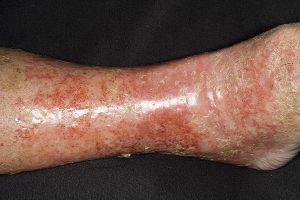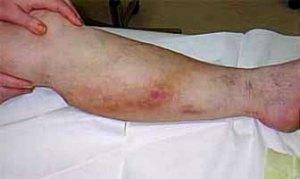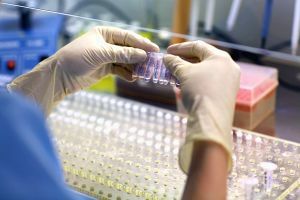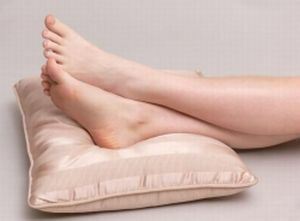 Chronic thrombophlebitis is a leg disease, usually due to venous insufficiency. The disease develops because of the thickening of the blood in the veins.
Chronic thrombophlebitis is a leg disease, usually due to venous insufficiency. The disease develops because of the thickening of the blood in the veins.
The reason is a violation of venous circulation, as well as a change in the location of veins in the body, they can become much more expressive than they should be.
As a result, a vital element is touched: cardiovascular system, blood circulation is disturbed, and skin deformation occurs in the area of the lower extremities.
Contents
- Symptoms of the disease in different stages of development
- Diagnostic techniques
- Objectives and methods of treatment
- Than a disease
- Preventive measures
Symptomatic of the disease in different stages of development
The first sign of the disease is discomfort in the limbs during movement, the legs begin to ache madly,- this is the initial symptoms of post-phlebitis syndrome.
As a rule, this disease does not immediately manifest itself, but manifests itself after several months and even years.
With further development of the syndrome the symptoms can be different:
- pain, aches and swelling of the legs;
- may have various ulcers, eczema;
- deformation of the skin on the legs;
- veins swell and protrude very close to the surface.
With post-phlebitis syndrome, the veins are clearly visible on the legs, the legs swell and in addition, this can manifest in combination with the aforementioned rashes.
As a sign of the disease is the contraction of the muscles in the leg during sleep, from which people wake up and can not fall asleep.
The skin becomes very thick, the feet are swollen.
Also these skin areas are strongly itchy and irritated.
This disease manifests itself in two forms: the first type is inflammation of the lower leg, and the second kind is the inflammation of the veins on the legs. The type of disease depends on the stage of the disease. 
Also distinguish three phases of the syndrome:
- first manifested in fatigue and swelling of the legs, as well as in the pains of the lower extremities at night;
- the second is manifested in more acute pain in the legs, as well as in external skin changes;
- and the third is characterized by all the described symptom in more complex forms with the addition of ulcers and eczema.
Diagnostic techniques
The check for the presence of post-phlebitis syndrome takes place in two stages.
The first step is to define the disease by external characteristics, such as swelling and swelling of the legs.
It can also be determined with the help of UZDG, which studies the condition of veins and the circulation of blood on them.
This device is by far not uncommon in polyclinics, so you will not be able to pass the diagnosis.
The next and final stage of your checkup will be a visit to the phlebologist doctor. He uses various special techniques to look at the extent of your illness and prescribes treatment.
Aims and methods of treatment
Therapy of this disease depends on the stage of the disease.
The primary goal in the treatment of this disease is to reduce stress and strain on the legs.
With the more complex form, which is characterized by swelling of the legs, deformation of the skin and various eruptions, sanatorium treatment and other methods of treatment are applied.
Massages, baths, physical exercises and wrapping of limbs are used to maintain them in an elastic state. Often used various drugs and tinctures to relieve inflammation and pain in the limbs.
 If the pain in the legs becomes permanent and strong, then in such situations, doctors can prescribe an operation. In the case of surgery, the veins are removed or dilated, they can also change the location of the veins for better circulation.
If the pain in the legs becomes permanent and strong, then in such situations, doctors can prescribe an operation. In the case of surgery, the veins are removed or dilated, they can also change the location of the veins for better circulation.
After the operation it is necessary to undergo a long and complicated rehabilitation.
The main task of the treatment is to remove inflammation in the extremities, relieve the pain and adjust the blood circulation through the veins.
Than the disease
is dangerous If the doctor does not turn in time and does not start treatment in time, the complications can be very different - disability, disability, venous and vascular insufficiency can develop, because of ulcers and eczema there can be various troubles with the skin.
Preventive measures
People who suffer from thrombophlebitis need to be constantly observed by the doctor.
Maintaining damaged parts of the body with elastic bandage is also an important part of prevention.
After the operation, health procedures are needed: 
- therapeutic physical exercise;
- massage;
- medical baths and others.
A blood transfusion is also used to prevent this disease, and all antiseptic rules should be adhered to.
Also used infusion therapy, - infusion into the blood of various solutions.
After the operation, drugs are used to improve the blood condition, as well as its circulation.
But in any case, you need to remember that when the pain or heaviness in the legs is overcome, you should immediately consult a specialist who can correctly diagnose you in time and cure the disease at an early stage.
